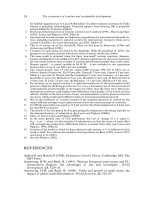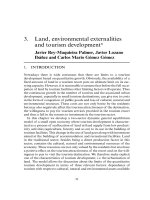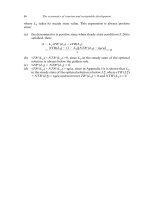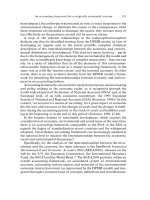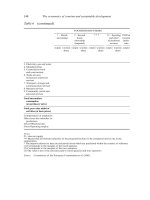THE ECONOMICS OF MONEY,BANKING, AND FINANCIAL MARKETS 739
Bạn đang xem bản rút gọn của tài liệu. Xem và tải ngay bản đầy đủ của tài liệu tại đây (44.74 KB, 1 trang )
CHAPTER 27
Rational Expectations: Implications for Policy
707
John Taylor, a proponent of the new Keynesian model, has demonstrated that
a more gradual approach to reducing inflation may be able to eliminate inflation
without producing a substantial output loss.7 An important catch here is that this
gradual policy must somehow be made credible, which may be harder to achieve
than a cold-turkey anti-inflation policy, which demonstrates immediately that the
policymakers are serious about fighting inflation. Taylor s contention that inflation
can be reduced with little output loss may be overly optimistic.
Incorporating rational expectations into aggregate supply and demand analysis indicates that a successful anti-inflation policy must be credible. Evidence that
credibility plays an important role in successful anti-inflation policies is provided
by the dramatic end of the Bolivian hyperinflation in 1985 (see the Global box,
Ending the Bolivian Hyperinflation). But establishing credibility is easier said than
done. You might think that an announcement by policymakers at the Bank of
Canada that they plan to pursue an anti-inflation policy might do the trick. The
public would expect this policy and would act accordingly. However, that conclusion implies that the public will believe the policymakers announcement.
Unfortunately, that is not how the real world works.
Ending the Bolivian Hyperinflation: Case Study
of a Successful Anti-Inflation Program
GLOBAL
The most remarkable anti-inflation program
in recent times was implemented in Bolivia.
In the first half of 1985, Bolivia s inflation rate
was running at 20 000% and rising. Indeed,
the inflation rate was so high that the price of
a movie ticket often rose while people
waited in line to buy it. In August 1985,
Bolivia s new president announced his antiinflation program, the New Economic Policy.
To rein in money growth and establish credibility, the new government took drastic
actions to slash the budget deficit by shutting
down many state-owned enterprises, eliminating subsidies, freezing public sector
salaries, and collecting a new wealth tax. The
finance ministry was put on a new footing;
the budget was balanced on a day-by-day
basis. Without exceptions, the finance minister would not authorize spending in excess
of the amount of tax revenue that had been
collected the day before.
The rule of thumb that a reduction of 1%
in the inflation rate requires a 4% loss of a
year s aggregate output indicates that ending
the Bolivian hyperinflation would have
required halving Bolivian aggregate output
for 1600 years! Instead, the Bolivian inflation
was stopped in its tracks within one month,
and the output loss was minor (less than 5%
of GDP).
Certain hyperinflations before World
War II were also ended with small losses of
output using policies similar to Bolivia s,* and
a more recent anti-inflation program in Israel
that also involved substantial reductions in
budget deficits sharply reduced inflation
without any clear loss of output. There is no
doubt that credible anti-inflation policies can
be highly successful in eliminating inflation.
* For an excellent discussion of the end of four hyperinflations in the 1920s, see Thomas Sargent, The Ends of Four
Big Inflations, in Inflation: Causes and Consequences, ed. Robert E. Hall (Chicago: University of Chicago Press,
1982), pp. 41 98.
7
John Taylor, The Role of Expectations in the Choice of Monetary Policy, in Monetary Policy Issues
in the 1980s (Kansas City: Federal Reserve Bank, 1982), pp. 47 76.





